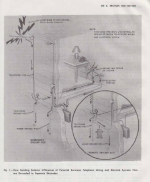Fred B
Senior Member
- Location
- Upstate, NY
- Occupation
- Electrician
250.94 Intersystem Bonding termination point required.Isn't there a requirement to have a ground bar in certain rooms that contain IT/ comm equipment? Article 700 something perhaps , Or am I making that up?
But never seen the telcom actually use it when provided. Installed on every new installation and come back after telcom comes in and they usually just tag onto the GEC with split bolt or a metal water pipe avoiding only 3 extra feet of wire. Even pre install on rough an interducting for them to use and come back to find holes drilled through the window sill and/or floors.
Caught one while on site and asked why he's not using the bonding bridge or the interduct and his response was "what's that? never saw one before". Home owners also complain to me that the telcom was drilling through their new window and floors, even after providing the interducting. Had a customer even make it seem that I should give a refund on the interduct installation seeing the telcom to stupid to use it.


